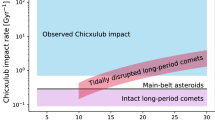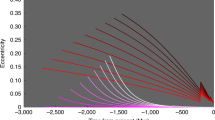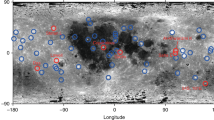Abstract
WHEN the Voyager 1 spacecraft flew through the jovian system in January 1979, it returned images of several prominent chains of impact craters on the surface of the moon Callisto (Fig. 1). These impressively straight chains, or catenae, are composed of between 4 and 25 craters, and are up to 620 km long. They were initially thought to be secondary craters produced by debris from a larger primary impact1, but detailed searches for source craters have been largely unsuccessful: a satisfactory explanation for the crater chains has yet to be found. Inspired by the recent observations of comet Shoemaker–Levy 9, which split into a line of about 20 fragments as it swept past Jupiter2, we suggest that the impact of previous split comets might be responsible for at least some of the catenae on Callisto. In support of this hypothesis, we find that nearly all of Callisto's crater chains are on the Jupiter-facing hemisphere, as are an additional three catenae that we have found on Ganymede. We present a simple model of tidal breakup which both reproduces the range of observed chain lengths and indicates that the parent comets responsible for the Callisto catenae were typically no more than about 10 km in diameter.
This is a preview of subscription content, access via your institution
Access options
Subscribe to this journal
Receive 51 print issues and online access
$199.00 per year
only $3.90 per issue
Buy this article
- Purchase on Springer Link
- Instant access to full article PDF
Prices may be subject to local taxes which are calculated during checkout
Similar content being viewed by others
References
Passey, Q. R. & Shoemaker, E. M. in Satellites of Jupiter (eds Morrison, D. & Matthews, M. S.) 379–434 (Univ. of Arizona Press, Tucson, 1982).
Chapman, C. R. Nature 363, 492–493 (1993).
Stacey, F. D. Physics of the Earth 313–317 (Wiley, New York, 1977).
Belton, M. J. S. in Comets in the Post-Halley Era (eds Newburn, R. L. J., Neugebauer, M. & Rahe, J.) 691–721 (Kluwer, Dordrecht, 1991).
Sekiguchi, N. The Moon 1, 429–439 (1970).
Dobrovolskis, A. R. Icarus 52, 136–148 (1982).
Dobrovolskis, A. R. Icarus 88, 24–38 (1990).
Press, W. H., Flannery, B. P., Teukolsky, S. A. & Vetterling, W. T. Numerical Recipes: The Art of Scientific Computing (Cambridge Univ. Press, 1986).
Scotti, J. V. & Melosh, H. J. Nature 365, 733–735 (1993).
Sekanina, Z. & Yeomans, D. K. Ast. J. 90, 2335–2352 (1985).
Author information
Authors and Affiliations
Rights and permissions
About this article
Cite this article
Melosh, H., Schenk, P. Split comets and the origin of crater chains on Ganymede and Callisto. Nature 365, 731–733 (1993). https://doi.org/10.1038/365731a0
Received:
Accepted:
Issue Date:
DOI: https://doi.org/10.1038/365731a0
This article is cited by
-
Sesquinary catenae on the Martian satellite Phobos from reaccretion of escaping ejecta
Nature Communications (2016)
-
Origin of pit chains in the floor of lunar Copernican craters
Science China Physics, Mechanics and Astronomy (2010)
-
Xenomict energy in cold solids in space
Naturwissenschaften (2006)
-
Craters unchained
Nature (1998)
-
Evidence for a late Triassic multiple impact event on Earth
Nature (1998)
Comments
By submitting a comment you agree to abide by our Terms and Community Guidelines. If you find something abusive or that does not comply with our terms or guidelines please flag it as inappropriate.



